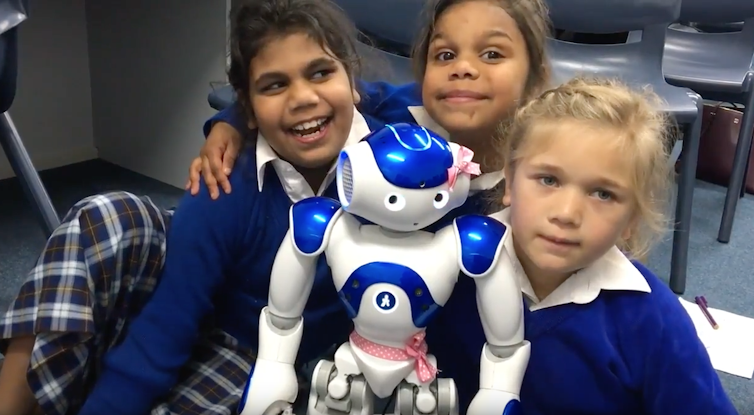A cute human-like robot taught students in a small, rural school how to code while also motivating them learn their local Aboriginal language.
The Maitland Lutheran School in South Australia, located on the traditional lands of the Narungga people, has around 240 students from Kindergarten to Year 9, and 16 per cent of them are Aboriginal or Torres Strait Islander.
The school wanted to support its Aboriginal and non-Aboriginal students and staff to connect with the heritage of the Narungga people, in partnership with the local Aboriginal community.
Past research has shown digital technologies with culturally responsive ways of teaching have helped to improve engagement and learning among Indigenous students in STEM subjects.
So, the school’s principal decided to employ a small robot named Pink to engage students in understanding their local culture and language. And it worked.
By learning to program a humanoid robot, students engaged with an Indigenous culture and language and strengthened the connection between school, home and Country.
Why did Pink work so well?
Humanoid robots look like humans and have movements that are human-like, so students are drawn to them and want to make them function like a human, by making them talk, move their arms and walk. Some research has shown school students feel more comfortable – less anxious and self conscious – learning a new language when they can practise on a robot compared to a human.
Apart from the cuteness factor, students believe the robot is not judgmental when they make mistakes.
How it panned out
It didn’t take long for Pink to captivate the students, as the children began forming relationships with the robot and becoming attached to it. One of the teachers said her students treated the robot like it was a younger child.
Another teacher said the students humanised the robot within seconds, touching Pink’s hand to shake it, talking to it and waving goodbye.
As the students’ enthusiasm and confidence using the robot increased, they wanted Pink to have more functionality, so they started learning how to program her.
They wanted Pink to speak Narungga, but they discovered she could not pronounce the Narungga words when they typed them correctly into the programming language. So, using their problem-solving skills, students trialled the phonetic spelling of the words until they achieved the correct Narungga pronunciation.
The excitement of Pink and her learning spread across the school community, as students and teachers began greeting each other with “Hello” in Narungga. It was clear that a strong sense of pride in the traditional culture of the area was developing.
The principal said it hadn’t just been fantastic for the school’s Narungga students, it had been valuable across the board with all students.
“It’s been a great way of getting them to network together … to work on something that has an Indigenous perspective but means a lot to everybody,” he said.
Emerging technologies can play a role in engaging the young with the languages and cultures of Australia’s First Peoples.
The educators in this school recognised the importance of coding and robotics for their students’ future and the far-reaching opportunities to integrate this technology in ways that build respect and understanding between cultures.
This project was part of a larger three-year study investigating the impact of humanoid robots on young children's learning and engagement.

Read more: Robots likely to be used in classrooms as learning tools, not teachers
This article was co-authored with Monica Williams, Educational Consultant at the Association of Independent Schools of South Australia.![]()
Therese Keane, Associate Professor, Deputy Chair Department of Education, Swinburne University of Technology; Christina Chalmers, Senior Lecturer in Education, Queensland University of Technology, and Marie Bodén, Academic in Research and School Outreach, The University of Queensland
This article is republished from The Conversation under a Creative Commons license. Read the original article.



